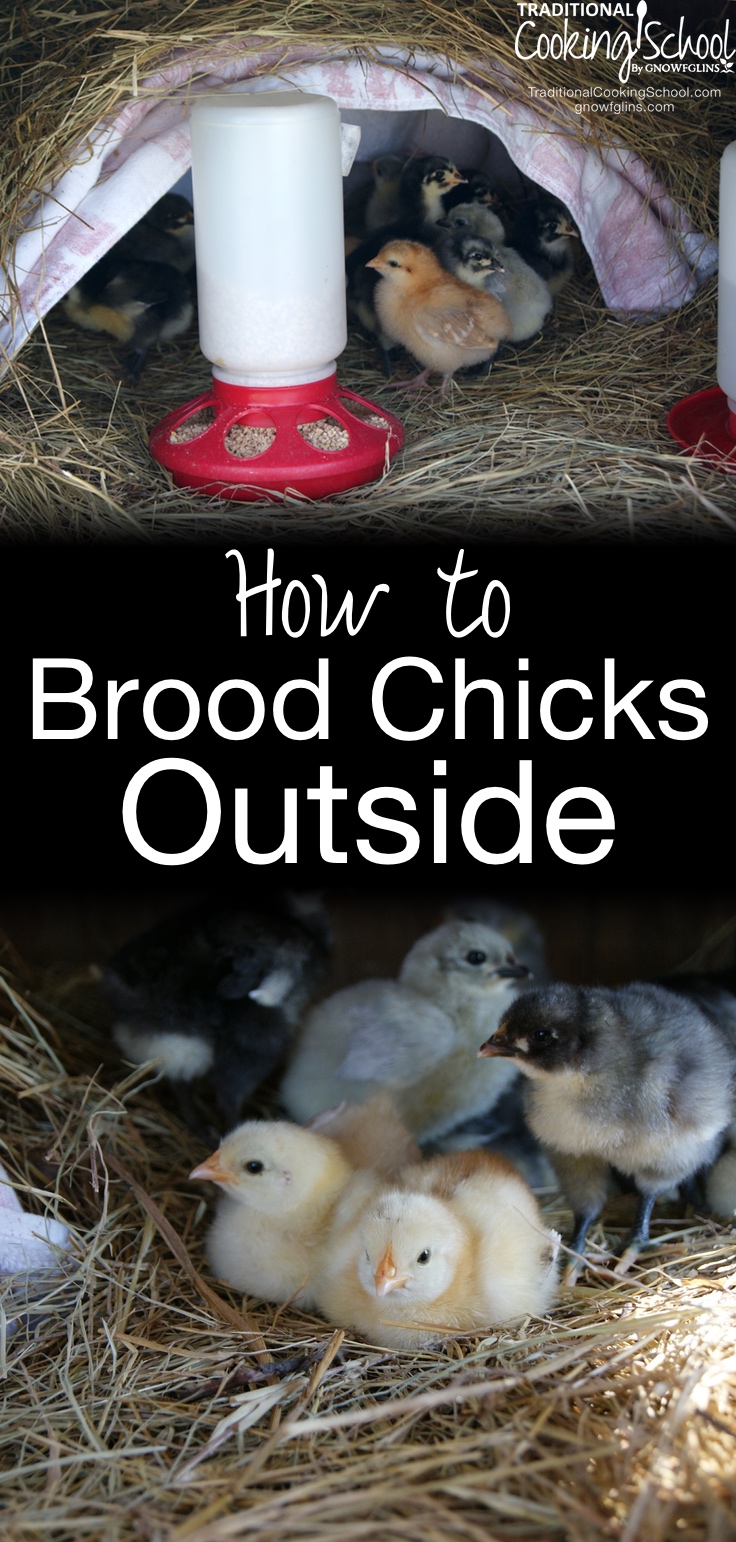
Confession: Until recently, we tended to our brooding chicks right in our home office.
Why? We spend most of our time in this room, so we can easily tend to the newly hatched chicks. Plus, it’s just so fun to watch them while we’re working!
This fun wears off by week two, however, when they have really started to grow and are capable of creating much more of a mess.
Mess = barn smell. Not exactly a pleasant odor to encounter first thing in the morning.
While browsing a chicken-keeping website recently, I was quite delighted to discover that it is possible to brood chicks outside.
I decided to try out what I had learned with a brand-new batch of chicks.
I assembled the supplies needed for the brooder, set it up just off our front porch where they could easily be monitored, and, at one week old, introduced 13 chicks to their new home.
Now eight weeks old, I have decided that brooding chicks outdoors is a win-win situation. For me, they are easier to care for and put up with. The mess and smell stay outside. For the chicks, outdoor brooding provides a more natural setting and a cleaner environment.
Here is what you need to give outdoor brooding a try:
1. Housing with Access to a Run
We have a small coop that we have used in the past for housing our meat birds. The coop is very simple: four walls with proper ventilation, a sloped roof that lifts for easy accessibility, and a door with a single latch. It sits on the ground and opens into a small, square, covered run. The top and sides of the run are completely covered with hardware cloth. We leave the coop door open and the chicks are free to come and go within the run as they please.
If you do not have a similar set-up, a large dog kennel would suffice. A large plastic bin turned on its side set within a safe enclosure would also work. Whatever you choose, the chicks need to be able to come and go from their brooder while being protected from any older birds or pets who may harm them.
Any openings in the fencing you use need to be small enough that the chicks cannot squeeze through and escape. Keep in mind that while chicken wire may seem like an ideal choice, a determined raccoon can easily tear it apart or even reach inside. Hardware cloth or dog run fencing fortified with an additional layer of hardware cloth is the best choice.
Whatever you choose, the run must be covered. I was glad of this one morning when I discovered a hawk sitting on top of our brooder, eyeing what he hoped to be breakfast. The chicks were frightened, but protected.
Be sure to situate your brooder and run close to an electrical outlet because you will need to provide…
2. Heat
The idea here is to mimic a mother hen. Her body provides the warmth growing chicks need as they come and go underneath her. While a heat lamp will work, a heating mat for pets is the best and safest choice. This option will provide a warm — but not hot — steady, constant source of heat. Wrap the heating pad in an old bath towel so the chicks do not come in direct contact with the surface. Drape the heating pad over the top and sides of a plastic shoe box or a tunnel crafted of wire.
The chicks should be able to come and go from under this “tunnel” just as they would their mother. Ours was fashioned from a tomato cage cut down to fit within a corner of the brooder. This has become their favorite spot to huddle together at night, as well as a warm perch during the day.
3. Bedding
We use hay cut from our acreage for coop bedding. Whatever you choose should be dry, safe for chicks, and changed out often to keep their surroundings clean. I put the hay on the floor of the brooder, inside their tunnel, and draped over the top. The hay further insulates the tunnel and provides additional warmth.
As mentioned previously, when our chicks were a week old, I decided to introduce them to their new home. I initially placed them inside the tunnel so they knew where to go to keep warm. Their food and water was placed close by so they had constant access to it. In a very short amount of time they had acclimated to their new surroundings and were happily thriving.
Have you ever used an outdoor brooder? What has your experience been?
...without giving up the foods you love or spending all day in the kitchen!

2 free books:
Eat God's Way
Ditch the Standard American Diet, get healthier & happier, and save money on groceries...
We only recommend products and services we wholeheartedly endorse. This post may contain special links through which we earn a small commission if you make a purchase (though your price is the same).


This is such helpful into for when we get chickens, Jenny!
Thank you Lindsey!
Rig up the pen so that it doesn’t have corners, so that birds cannot get trapped and trampled in a corner.
If using a light for heat, make sure to put in another (low watt) light, so that if the heat light burns out, the chicks don’t panic-and trample themselves in a corner, for example. (Ask me how I know.)
Also, if using a light for heat, make sure there is enough room for the chicks to spread out if it is too hot…and raise the light up a bit. The chicks will huddle together in a knot if there is not enough heat…lower the light, then.
You will most likely have to raise the lamp as the weeks go by, until it is no longer needed. (Unless you are trying to raise chicks in winter!)
Make sure the wire you use is too small for rats to squeeze through it-which will also prevent ‘coons from reaching through and grabbing and killing a chick with their hands. (If you happen to use wire open enough for this, then make sure the heated space is at least 8-10 inches or more away from the fence.)
Also, hay or straw is cheap, but gets “dirty” rather quickly and molds readily…stay on top of cleaning, if you use it.
But if you live in bear country-you might as well give up-although most states allow for “bear control” when they are eating your chickens-but not if they are bothering you or your dogs or your song bird feeders, or even your children-Only when “livestock” is bothered. (Again, ask me how I know.)
Short of any of the above problems-raising chicks is easy.
Great tips Wilson, thank you! As far as bears in the area, we fortunately do not have a problem with that. Coyotes, opossums, racoons, and hawks are a different story. I agree though, raising chicks is pretty easy and a lot of fun.
Thank you for the response. We also have every one of the critters but bears. We also have a bobcat in the area. We do make sure that there is ventilation, but we have to give them a place away from the snow. I love the idea of rounding the corners to avoid trampling. Thank you for that!
Thanks for the post. I presently have two chicks in my craft room. haha. We live in Western New York, so it is fairly cold out already. I know it is easy for chicks to die from respiratory illnesses, so I thought it was better to have them in the house. We were not originally going for chicks, we wanted a hen almost ready to lay. We took what we could get and figured we would let them be inside until they were stronger and older. I am thinking I can soon introduce them to the coop with the other hens. We have the coop and run covered with a roof (to prevent the hawk incident. We just covered the walls with plastic to both keep it warm and dry. The chicks are in a bunny cage that I was thinking of moving into the coop and covering for warm. I like the heating pad/towel idea. You don’t think it could ignite the straw? We use wood shavings. I was going to use the heat lamp with a regular bulb.
We also put our hens “to bed” at night. The go up a ramp into a raised boxed area that we close a door to at night. This is extra protection against the wildlife in our area. We extended the box so that there is a box outside of the barn (in the coop) ad then inside the barn. The hens sleep in the inside box on a perch. I was thinking that the two chicks should be put in the outside box at night. Do you think I should block off the two areas with chicken wire? I don’t know if the larger hens will bully the two chicks. What is your experience with that?
Thanks again for the post!
Hi Deborah,
As far as burning straw: I did not have a problem with that or a concern. The heating pad gives off more of a warm vs. hot heat. In fact there were times I was worried that it was even on, the temp was so mild.
If you put the chicks in to bed with your chickens, I would definitely recommend blocking them off and separating them from the hens until they are of a big enough size to hold their own. Chickens are very territorial, and depending on the breed, working out the pecking order can get ugly. It is best to have chicks in an area where they can be seen but not hurt. When you do decide to integrate them with your older flock I would do it at night when they are less active.
I hope that helps and good luck with your chickens. 🙂
Thanks!
Two chicks are harder to manage than 22, because 2 cannot huddle together for body heat.
I’m not sure about the rabbit cage-could they get far enough away from the heat, if it was too hot?
You definately need a thermometer…and Murry McMurry online has a chart you can use for heat by age of chick.
And no, there is no value to putting the chicks out at night (except for less mess to clean up) because you still need to keep them at specific temperatures (based on age) both day AND night.
I have NO experience with heating pads, but pet stores used to carry a heating mat for reptiles that was supposedly safer-that is, water resistant-although none of my friends with reptiles ever used them. (Maybe because reptiles don’t feel heat link warm bloods, and might not move away it it got too hot?) And how in the world, with a heating pad, could you have it at 90F for the first week, but lower the heat bit by bit until it was room temperature when the chicks were feathered? I’d stick with a lamp, provided you had about three feet the chicks move to get away from it so that they could pick out their favorite spot of warmth. (To lower the heat, you just raise the lamp up.)
I can tell you that many hens will peck a chick, sometimes to death. So…put a wire divider into the pen that neither hens nor chicks can go through, but that they an look at each other through. After a while, you can put a wire divider into the pen that the chicks CAN go through, but the hens can’t. Hopefully, the hens got used to the chicks and leave them alone, but the chicks can get away (if they are smart enough) if the hens do bother them…but its still a big risk if the chicks don’t have any feathers to deflect a peck. Someone mentioned doing this at night-and I agree.
By the way, protection from cold is ok (although grown chickens need less protection than you would guess) but it is absolutely vital that there is a way for fresh air to vent into a cage or pen. (It need not be “drafty”.) No fresh air=pneumonia and/or other respiratory diseases.
Hope this helps.
We have been letting the chicks (14 weeks old) outside on sunny dry days in the afternoon. They are out with the 4 hens. We are out there with them and watch to make sure they are behaving. Our king charles spaniel/papillon blend is out there along with our cocker. They watch over the chicks. The king charles spaniel/papillon acts like he is their mama. haha. If the hens come too close he sticks his nose right between them. He also will run into the craft room and check on them if he hears them squaking.
I have had friends tell me we need larger dogs, but they hold their own. The cocker even protected us from a coyote a few years ago. Our dog had the upper hand of being on the road, while the coyote was down in the field across the street. They both showed teeth and growled while I was screaming and clapping like a fool and running towards them. (I am sure you are all laughing at this one). It makes me smile now, but not while it was going on. I think they would protect the chickens as well as my husband and I.
Last year I had two broody hens raise one chick from an egg that one of them laid. They completely took care of the chick. All we did is leave available some feed for chicks and a chick waterer. I now have one hen gone broody. Could I expect her to take care of 6 (legal minimum purchase) chicks purchase from Tractor Supply at one time or do I have to raise them inside? I have no idea. It was sure easier when the hens raised the chick and I have not bought other equipment yet.
Lori, If the chicken is currently in a broody mood, she might be inclined to foster your chicks. I have never tried it before myself, but from what I understand, the best thing to do is to introduce her to them in a dark place. See if she spreads her wings, and begins to cluck. If so, she may take them in. If not, you’ll need to brood them yourself.
Thanks, I will try that. Better get a heat lamp in case.
Hi! Is the link to the heat mat the one that you used? I’m reading the details and it says it only heats to just above ambient temperature until the dual thermometer senses body heat on it, at which point it warms to the temperature it senses to maintain that temperature. I’m wondering how that works for chicks who won”t be on it, but rather under it. I was about to click order bc my chicks are arriving soon so I’d love to know if this is the one you use or if you have a link/brand name of the one you did use. Thanks!
Kate, this is the one that we used. The mat, combined with the towel wrapped around it and the hay underneath it was sufficient. Please keep in mind though that my chicks were about one week old, and it was still very late in the summer/early fall when daytime and evening temperatures were still somewhat warm.
Thanks so much! I appreciate your help a ton!